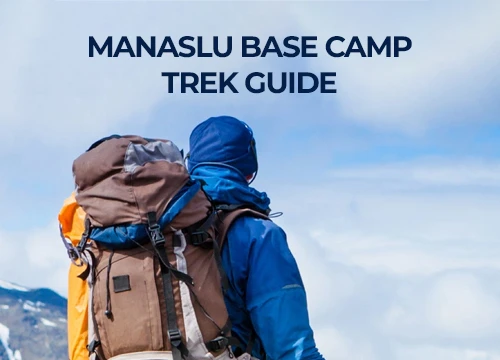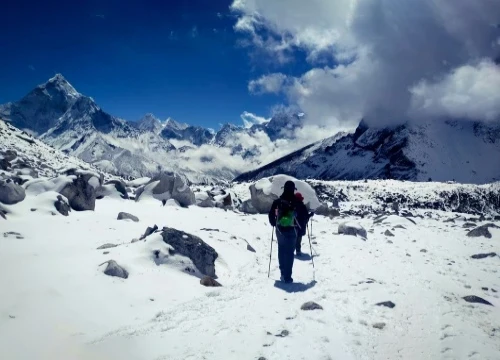What Does The Everest Base Camp Trekking Trail Look Like?
Well in some words the Everest route is difficult. The trek is considered a challenging yet rewarding journey. Trekkers need to walk in steep dry and dusty trekking trails with boulders and slippery trails along the way filled with ice or snow. However, trekkers need to understand that the trekking trail of Everest differs in different seasons. Mentioning that the best season to trek to the Everest region is during spring and autumn. Spring which lasts from March to May and autumn which lasts from September to November are considered the peak seasons of trekking in Nepal.
During these times the weather condition for a comfortable trekking experience is mostly favored. The season offers an unobstructed view of the mountain peaks with clear skies and offers a longer day to walk due to the longer day length.
The trails during the period are either vegetated with greenery or we can see the dry brown field which persists during the fall. Visitors get to pass through various terrains, including lush rhododendron forests that paint the hills pink and red. Similarly, the cool breeze and warm mountains welcome everyone who wishes to take on the challenge.
The Everest Base Camp roadmap allows trekkers to pass through various Sherpa villages paved with stone steps and route on the beginning half of the trail. The stroll around the Sherpa village is on these stone paved roads with narrow pathways. On both sides of the route hotels, shops, and vendors are available. In settlement houses, one can see mules or horses as a means of transportation.
The beginning of the route is through such settlements followed by a forested walk inside the juniper, oak, or fir trees. The trails here are filled with fallen leaves with regular ups and downs. One can encounter zig zag roads that eventually move on the higher elevations with only a few sections where trekkers walk on a flat surface.
During the walk to Everest Base Camp, trekkers will cross through numerous suspension bridges and view waterfalls and rivers. While moving on the second half of the Everest Base Camp trekking map trekkers will leave behind vegetation with only few to no looks at greenery. The walk consists of a steep climb uphill filled with boulders and ice. The mountain passes consist of frozen routes which can be slippery. Similarly, the path is windy and dry causing problems during the walk. The cold temperature comes into play in this leg of the walk. With depleting oxygen at every elevation level endurance and physical fitness is tested.
The Top Attraction In Everest Base Camp Trail
Lukla (2,860 meters/ 9,383 feet): The Gateway of Everest
Lukla, a small town in the Khumbu Pasang Lhamu Municipality, is the first location on the Everest Base Camp trekking route. With the literal meaning “place with many goats and sheep,” Lukla serves as a gateway to the Khumbu region. While taking an airplane or helicopter towards the Khumbu region, Lukla is the place to land. The Tenzing Hillary Airport airstrip located in Lukla is the most common medium of travel for tourists and visitors who wish to continue on the Everest Base Camp Trail. The small town of Lukla is where trekkers are seen arranging their luggage and discussing how to carry on the trek further as the official trek on the Everest region begins here.
Similarly, the weather of Lukla is a popular topic among many individuals as the flights incoming and outgoing are highly influenced by the weather conditions. The high-velocity wind and rapidly changing weather conditions with an extremely short airport runway of 527 meters make the Lukla flights one of the most dangerous flights in the world. Mist, fog, rain, and snow are the common weather possibilities in the Lukla flight. Likewise, the duration of flight takes about 30 to 35 minutes from Kathmandu to Lukla.
Phakding (2,610 meters/8,563 feet): The First-Night Stay
Phakding is located above Lukla and as the official trek to the Everest region trek starts from Lukla the first night of stay is Phakding. The Sherpa village located along the Dudh Koshi River offers a mild introduction to the Himalayan region of Nepal. To reach Phakding from Lukla trekkers usually cross two suspension bridges before getting to Thadokoshi. Upon following ThadoKoshi walkers can see the Dudh Koshi River on the left. Then following the Dudh Koshi River one can reach the beautiful village of Phakding.
Visitors can see Mount Numbur, Kongde Peak, and various traditional sherpa villages during the walk from Lukla to Phakding. Tibetan monasteries, mani walls encrypted in chants, mani rocks, and colorful prayer flags are seen in the walk.
Monjo (2,835 meters/9,301 feet): The Sagarmatha National Park Checkpost
Monjo which lies just north and ahead of Phakding is a prominent place in the Everest Base Camp trek. Monjo is known for its army check post where documents and permits are thoroughly checked. As Monjo is the entry point for Sagarmatha National Park, a protected area marked by the Government of Nepal permits are required to enter.
Permits like the Khumbu Rural Municipality Permit and Sagarmatha National Park Entry permit are checked here. Remember if any of these permits are missing entry will not be allowed. Similarly, be sure to carry a passport during the trek.
Mountain peaks including Mount Everest, Lhotse, and Nuptse are seen from here. Another highlight of Monjo village is the iconic Tenzing Hillary suspension bridge which spans over the Dudh Koshi River and is surrounded by colorful prayer flags.
Namche Bazar (3,440 meters/11,286 feet): The Vibrant Hub Of Everest
Namche Bazar formally known as Namche Village Development Committee is a trading center and hub for tourists travelling in the Everest Base Camp. The major thing about Namche is its suitability for acclimatization.
Namche is a famous rest point where most of the national and international tourists spend an extra day to adapt to the lower oxygen level. The hike to Everest View Hotel situated at 3,962/1300 feet is a suitable acclimatization activity offered by Holiday Tours Nepal. The Everest View Hotel provides a panoramic view of Mount Everest, Ama Dablam, Nuptse, Lhotse, Khangtega, Thamserku, Taboche, and Khumbila.
Other activities in and around Namche are the visit to the Sherpa Cultural Museum, Sagarmatha National Park Museum, Irish Pub, Syangboche Panorama View Point, Shepa Panorama Hotel, and Saturday Market.
Tengboche (3,860 meters/12,664 feet): The Oldest Monastery Of Khumbu
Tengboche is the next overnight destination after Namche Bazaar which is located at 3,867 meters/ 12,687 feet. There is an iconic and important monastery situated in Tengboche known as the Tengboche Monastery. This monastery is also regarded as the oldest and the largest monastery in the Khumbu region.
Only male monks with bald heads and saffron color clothes are found here. They bless all the trekkers and explorers who wish to visit the Sagarmatha region. Similarly, the monastery located in the backdrop of majestic Ama Dablam portrays the panoramic view of the mountains in the Everest region.
The monastery is constructed in the Tibetan and Nepalese architectural styles. Once moving inside one can see the main prayer hall known as Dukhang. Similarly, the walls of the halls are decorated with Traditional Tibetan Buddhist artwork, thangkas, and various other statues resembling the sherpa culture.
Likewise, the Mandi Rimdu festival which is considered one of the largest and most elaborate festivals for Sherpas shows a visual representation of good and evil. The festival typically is carried out in Tengboche monastery where it features masked dances, comical skits, construction of colorful sand mandalas, butter offerings, and several monks reciting prayers. The festival typically takes place for 19 days during September and November.
Dibouche (3820 meters/12,532 feet): A Potential Stop
Dibouche or debouche can be a potential stop between Tengboche and Pangboche during the Everest Base Camp trekking. The walk from Tengboche to Dibouche takes about half an hour and is good resting place. There are several accommodation options here to provide refreshments for the trekkers.
Pangboche(3,985 meters/13,074 feet): Home To Pangboche Monastery
Pangboche is another beautiful stop during the Everest Base Camp trek. Located after Dibouche, the Pangboche is home to another beautiful monastery known as the Pangboche Monastery. Pangboche monastery considers itself to be the oldest monastery in the Khumbu region dating back to 300 years. However, there are doubts between the Pangboche and Tengboche monasteries claiming which is the oldest one in the region. The Pangboche monastery homes only nuns and they take care of the monastery. The nun here teaches young ones about the culture and religion of the Sherpa community.
The monastery includes several buildings with a main prayer hall, living quarters for the nun, and other structures that reflect religious ceremonies, intricate woodwork, and Tibetan styles.
The view of Everest, Ama Dablam, Thamserku, pristine valleys, lush forests, and cascading rivers are seen from Pangboche. Pangboche is also a suitable stop for accommodation providing trekkers with warm food and the hospitality of Sherpa people.
Dingboche (4,410 meters/ 14,468 feet): Second Acclimatization Stop
Dingboche is another sherpa village located in the Khumbu valley of Everest. It is also the last village in the Everest region and a suitable acclimatization stop before reaching the Everest Base Camp and Kalapatthar. During the acclimatization day to minimize the effect of Acute Mountain Sickness or altitude sickness, trekkers hike to the Nangkartshang Peak (5,121 meters/ 16,801 feet). The peak is worth the visit as it provides the best view of the Imja Valley. The three highest mountains in the world including Mt Makalu, Lhotse, and Cho Oyu are seen from here. Other mountain peaks like Ama Dablam, Kangtega, Island Peak, Thamserku, Cholatse, and Taboche are seen from the viewpoint.
Lobuche (6,119 meters/20,075 feet): Best View Of Lobuche Peak
Lobuche village lies just above Dingboche and further walking from Lobuche leads to Gorakshep. This sherpa village contributes to the view of the peak Lobuche including the Lobuche Far East, Lobuche West, Lobuche East, and Labuche Kang. Being situated close to Everest Base Camp provides a suitable medium for trekkers for accommodation and good food. There are several basic tea houses to more luxury houses in Lobuche where a larger number of trekkers can spend the night even in peak season. Similarly camping at Lobuche is also available. Holiday Planner Nepal can arrange camping in Lobuche upon personal request.
Gorakshep (5,164 m/ 16,492 feet): The Final Accommodation Option
Gorakshep located at an altitude of 5,164 meters (16,942 feet) is the last accommodation option before Everest Base Camp. As Gorakshep is located at such an altitude, it is closed most of the year and opens only in trekking season. During severe climatic conditions, the people of Gorakshep come down to avoid the freezing temperature.
Besides that, Gorakshep only provides basic amenities to the trekkers. As the supplies need to be carried from the lower altitude to this altitude it becomes difficult. So, they keep it simple. In the early days, Gorakshep was the base camp for Everest climbers.
Everest Base Camp (8,364 meters/17,598 feet): Trekker's Dream Destination
Everest Base Camp is the ultimate destination for trekkers and mountain climbers. There are two base camps of Mount Everest known as the South Base Camp and the North Base Camp. The South Base Camp lies in Nepal, whereas the North Base Camp lies in Tibet.
During the climbing season, the Everest Base Camp is filled with yellow tents which is the camping site of climbers. The iconic rock with the marking Everest Base Camp 5,364 meters is a prominent place to capture photographs marking the successful trekking towards the base camp. Similarly, the view of Nuptse, Lhotse, and Ama Dablam can be seen from the Base camp which is truly a trekker's dream destination.
Kalapatthar (5,644 meters/18517 feet): The Best View Of Everest
Kalapatthar situated at 5,545 meters is another place in the Everest Base Camp trekking trail. Although not directly on the route, many trekkers add Kalapatthar as a must-visit place during their journey to Everest Base Camp. This is because Kalapatthar provides the best view of Mount Everest with a mesmerizing sunrise and sunset view that is not to be missed. The pink and red shadow that is forecasted by the sun on the mighty Everest adorns everyone.
Kalapatthar can also be visited during the Everest Base Camp helicopter tour if there are two passengers. Landing in Kalapatthar is not available for those who exceed two passengers. Lying at the southern ridge of Mount Pumori of the Mahalangur range, it provides a 360-degree panoramic view of mountains including Nuptse, Changtse, and Everest.







